WARNING!
You are exiting the game and all of your progress will be lost. Are you sure you want to return to the main menu or game mode selection page?
How to Play
How to play tutuorial text here.
Tutorial
Bank Type | Symmetry | Starting Point | First Piece | Repeating Unit | Build the Shape | Infinite Patterns | Tips
Solving Nano Building puzzles can seem hard at first. But with a few tips, it can be a bit easier. To solve these puzzles, there are a couple things you want to look for to help you simplify the shape you need to build. One is symmetry...do any sides of your goal shape mirror the other? You can also look for repeating units. Do you see the same smaller shape repeated within the larger shape? Let’s take a closer look at one process that might help you solve challenges in the Game mode.
Step 1: Bank Type
First, look at the bank type. If bank type is Limited, count the number of blocks you see in the pattern. That’s the number of blocks you’ll need to add to your block bank.
Step 2: Symmetry
Next, identify what kind of symmetry is present in the goal shape. Can the shape be cut in half and mirrored across 1 or 2 directions? Or does the shape have identical arms extending in 2 or 4 directions? Below are 4 possibilities.
- No symmetry
- Symmetry in 1 direction
- Symmetry in 2 directions
- Rotational symmetry (4 arms are the same, but rotated 90 degrees each time)

Step 3: Starting Point
The next step is to identify your starting point. If there’s a center piece, that will be your starting point. If there’s rotational symmetry but no center piece, or no symmetry, the corner is a good place to start.

Step 4: First Piece
Next, build the center piece (if there is one). These are 3 possibilities, based on what type of symmetry is present. The examples below use maroon and gold, but these could be any 2 different colors.

Step 5: Repeating Unit
Identify the repeated units you’re trying to build (if there’s symmetry). There might be more than one possible way to break up a shape into repeating units that will work.
For mirror symmetry, the subunit colors on the blocks for each side of the mirror will be the same. But, the order of the subunit colors on the corner pieces will need to be mirrored. Focus on building just 1 unit first. Then build the mirror side using the same subunit colors on each block, but mirror the subunit colors on the corner pieces.
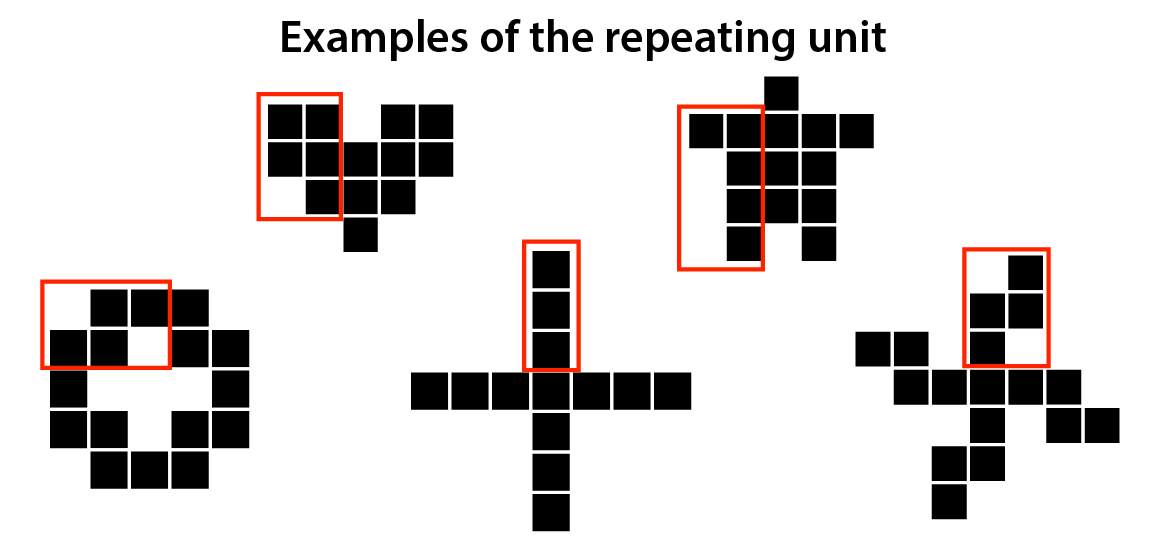
Step 6: Build the Shape
Once you’ve identified your starting point, look at the goal shape 1 block at a time adding blocks as you go. Pay attention to what’s next to the block you’re building. Is there another block next to it? If so, you’ll need to add a subunit color on the correct edge so that it can bind to the next block. If there is no block next to that edge, leave the subunit unbindable (grey).
In a Limited bank, you need to add the exact number of blocks to the bank to build the goal shape. In the Unlimited bank, an unlimited number of blocks of the type you selected are used. So, in an Unlimited bank, you only need one copy of a specific block in the bank.
Let’s look at 3 examples.
Example 1

Example 2 (Limited Bank Only)
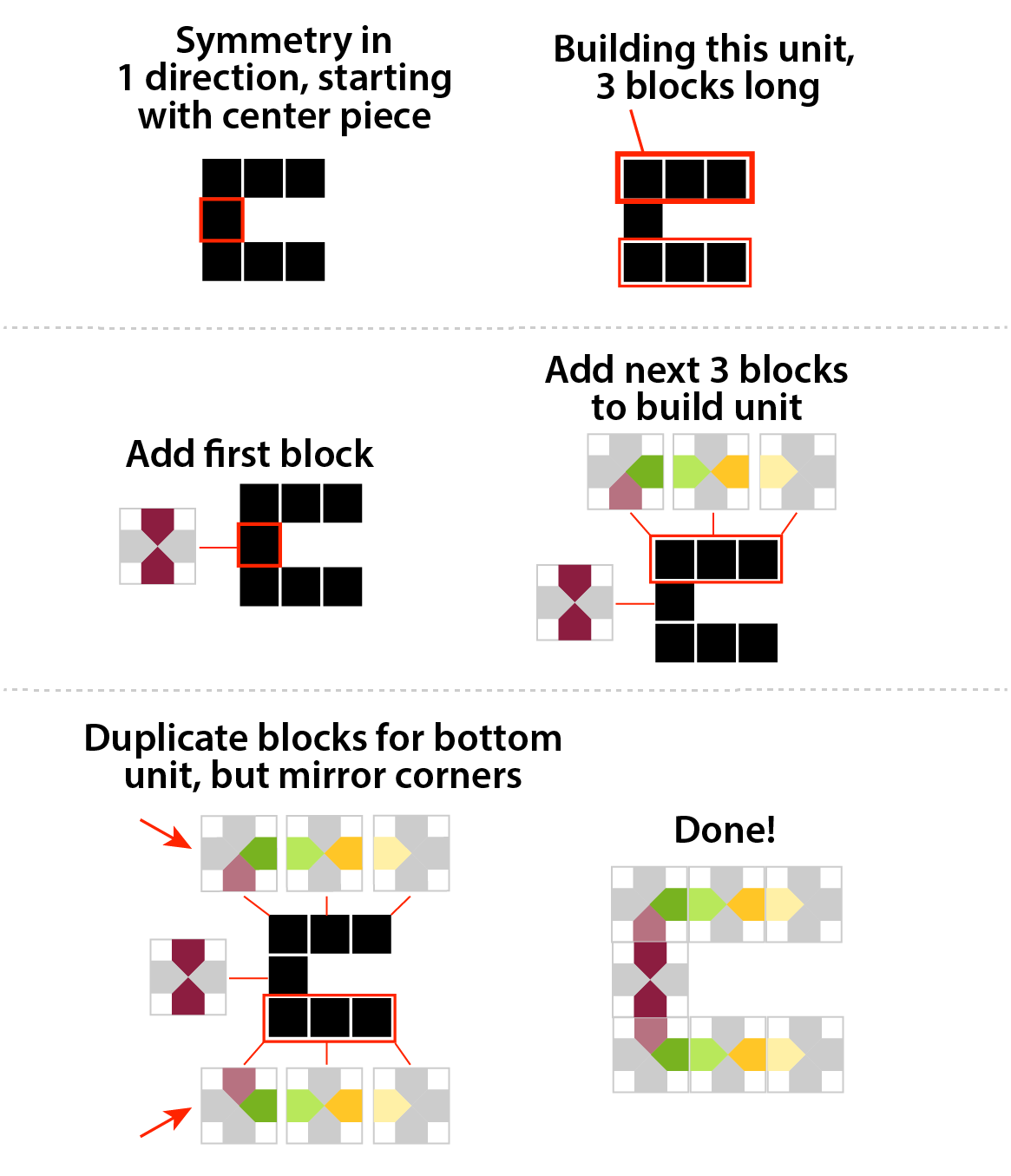
Example 3 (Unlimited Bank)
In an Unlimited bank, an unlimited number of blocks of the type you created will be added in random order. Because of this, you need to plan shapes a little more carefully.
What would happen if we tried to use the solution from Example 2 in an Unlimited bank? As seen in the image below, a couple different shapes could result. You would only get the correct result 1/3 of the time, which is not a good solution.
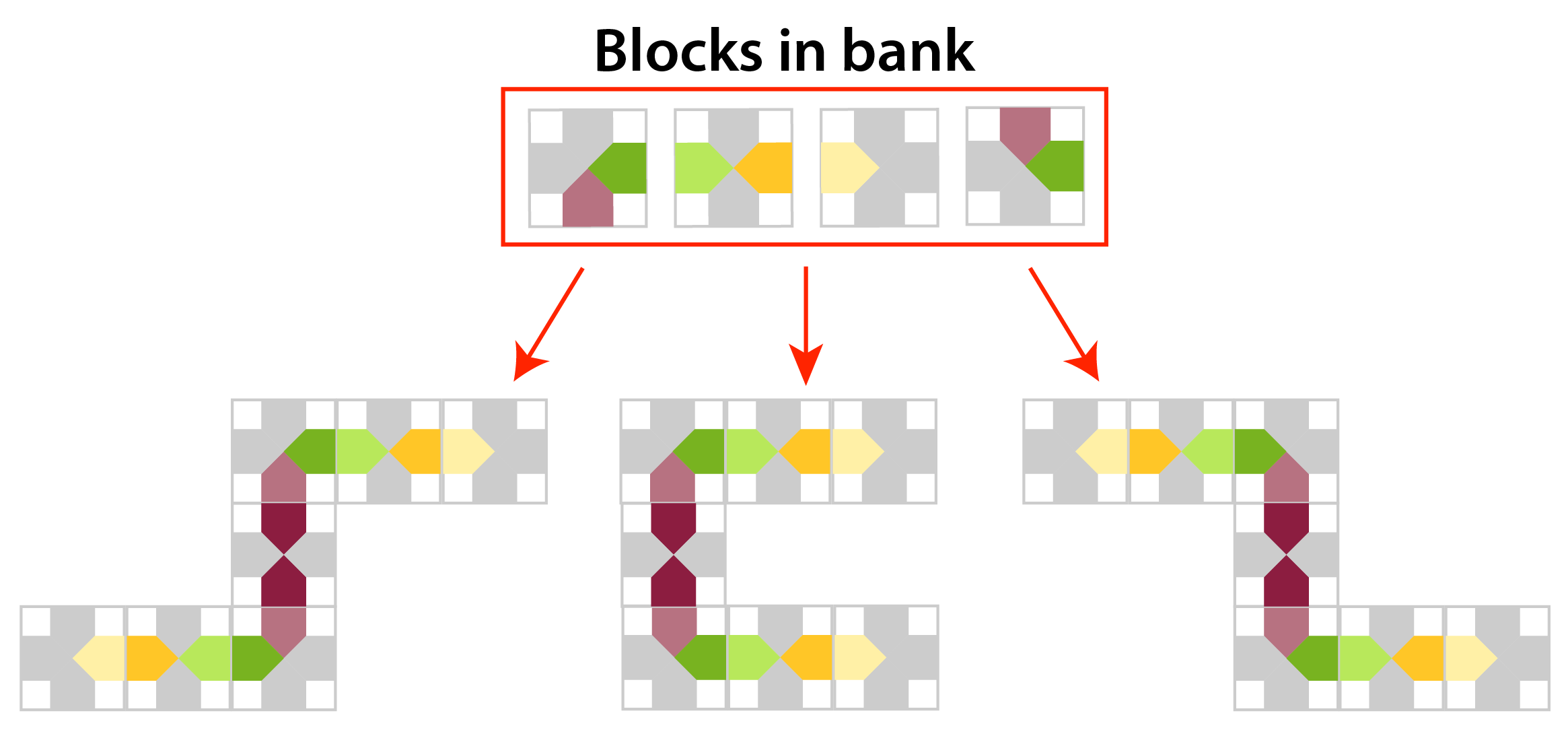
When a combination of blocks can make many different shapes, this is called a non-deterministic solution. When scientists use nanotechnology in real life in their labs, it’s important for them to find solutions that create the correct molecules almost every time.
So, how can we improve the solution? We can use a different color to connect the center block to the mirrored side. Now, when you run the simulation, there is only 1 possible result. The best solutions are those that make the correct shape every time. These are called deterministic solutions.
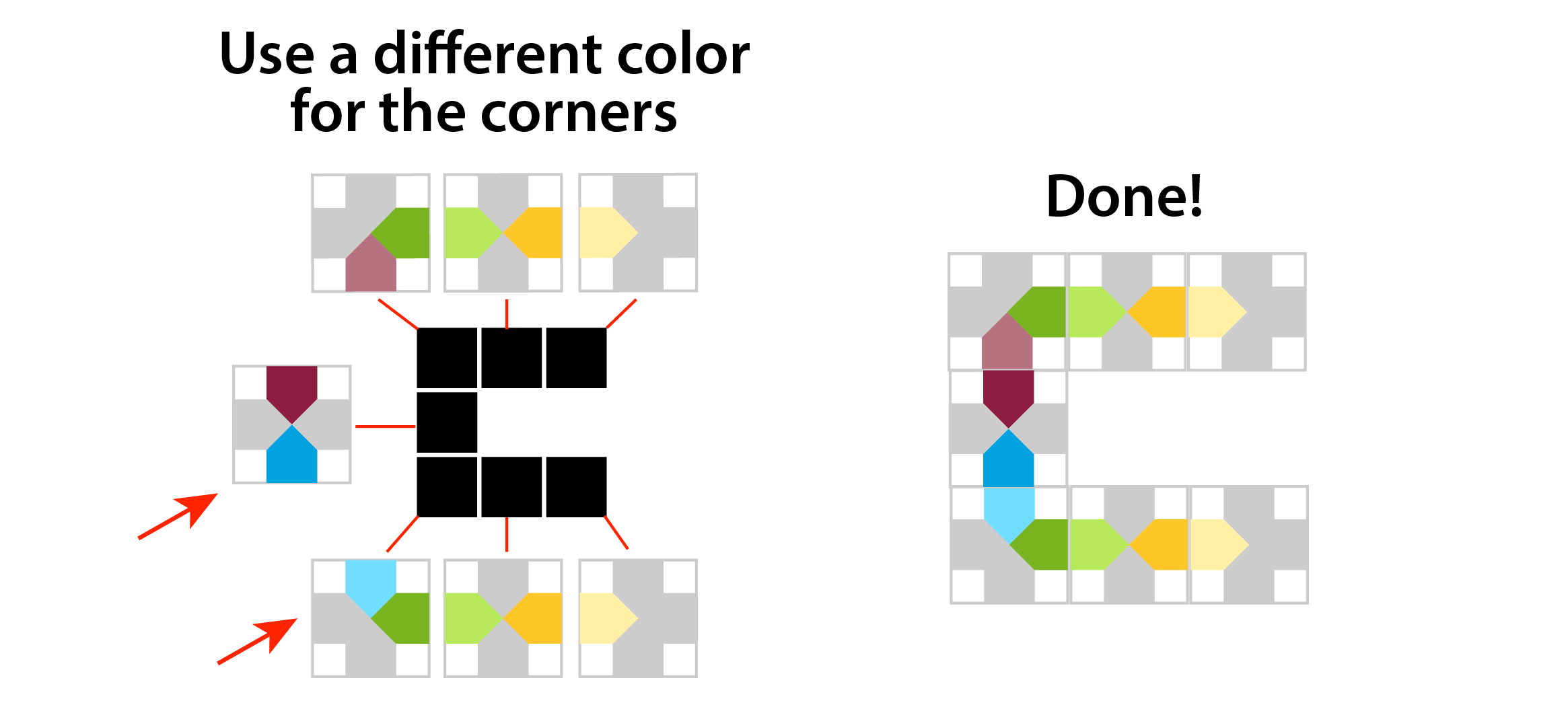
Infinite Patterns
To solve infinitely repeating patterns, you must first take a close look at the pattern and identify the smallest possible repeating unit. There are many ways to break up the pattern. All of them will work, as long as you make sure to include the correct subunit colors to bind to the next repeating unit.
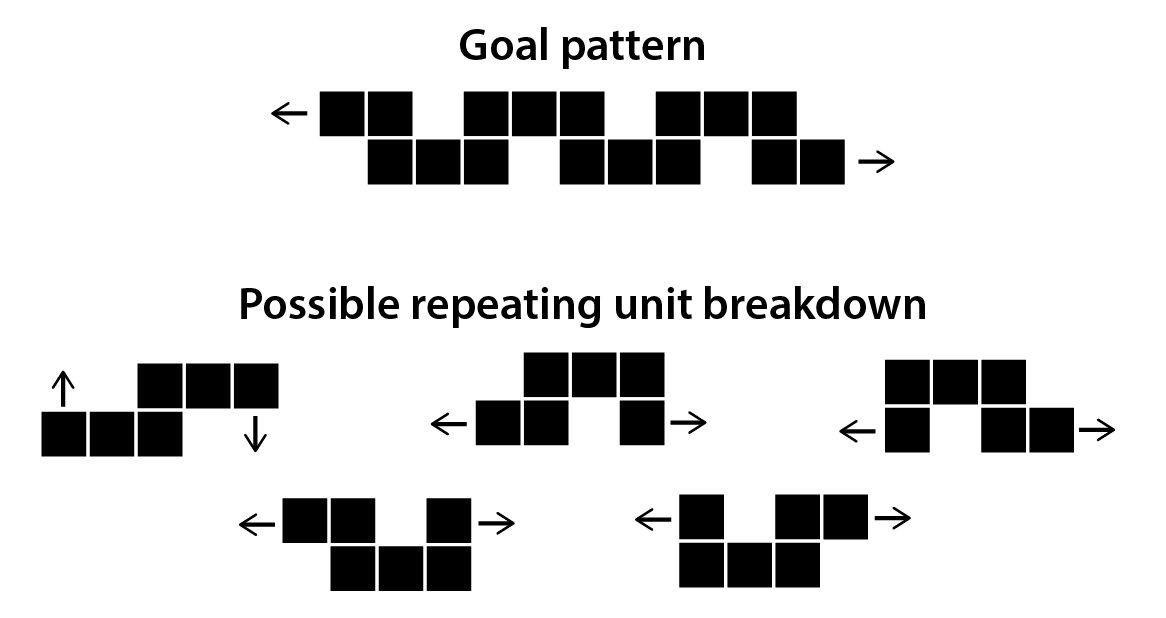
Once you have identified the repeating pattern, follow steps 1-6 to build the repeating unit. The only difference is that you’ll need to make sure the edges of your unit are able to bind to the edges of the next unit.
Many Solutions!
This is just one approach. There are other ways to think about solving these. Sometimes, more than one kind of symmetry is present and sometimes more than one solution is possible for each shape or pattern.
Super blocks
You won’t need the super (black) block to solve any challenges, though it can be used. Beware - using this subunit often results in a big loss of control over the shape you’re trying to build. This is because it can bind to anything instead of just one specific color.
Bonus Game Challenges
You’ll have to use all your puzzle-solving skills to solve these extra tricky challenges. You may need the empty (white) subunit to solve a few. Some of these challenges even have 2 different sets of repeating units combined into 1 pattern! To solve those, first identify the different repeating units. Then, solve each individually and then figure out how to connect them.
Good luck!
Tip
Still feeling uncertain about how to proceed? It’s OK to experiment! Begin with the parts that you do know, then try adding one block and color at a time to see how that impacts the patterns created.